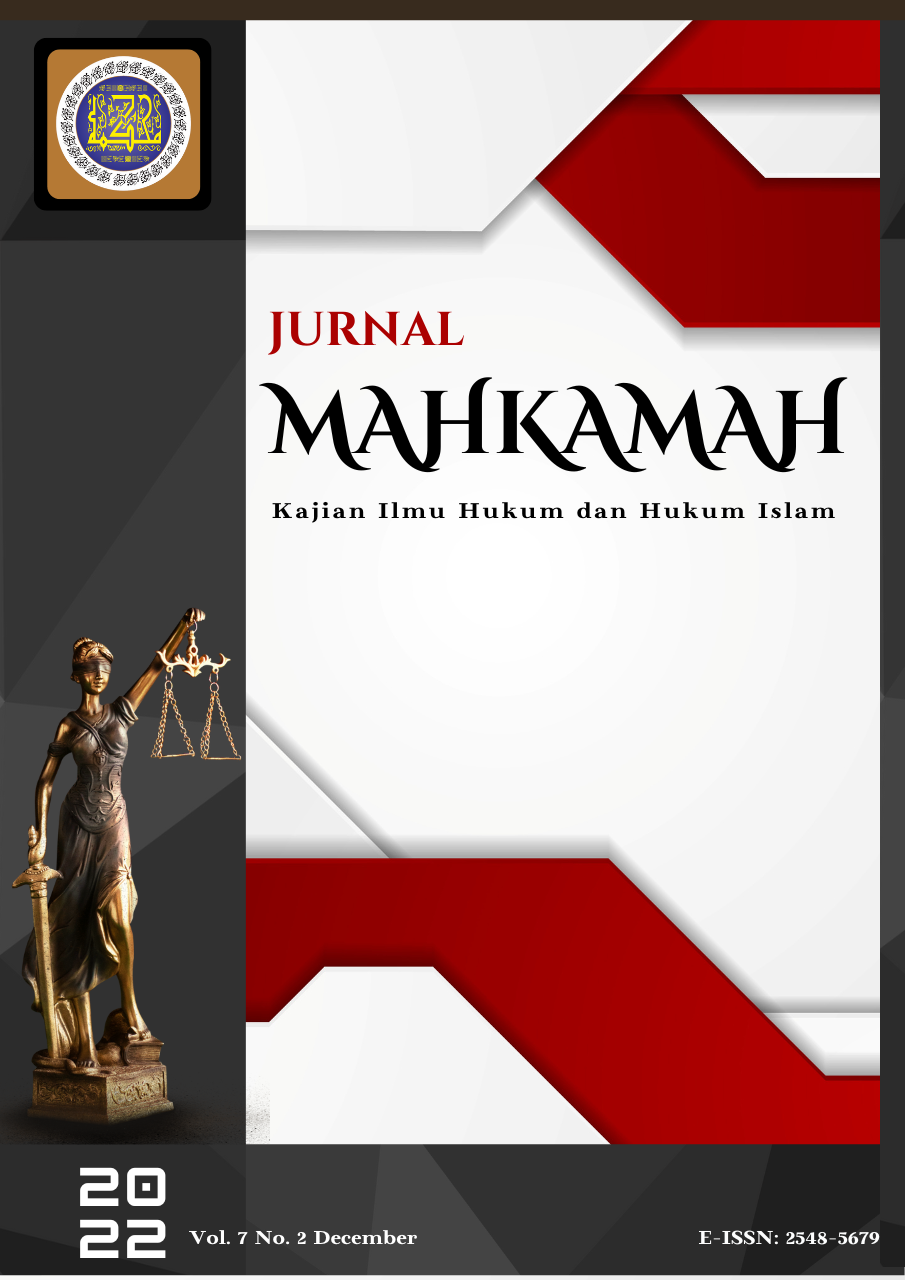Islamic Law and Human Rights: Doctrinal Controversies in Sunni and Shia Islam Since The 1948 Universal Declaration
DOI:
https://doi.org/10.25217/jm.v7i2.2783Keywords:
Human Right, Islamic Law, Theology, Sunning, ShiaAbstract
From a comparative perspective, this article analyses the doctrinal debate that arose in Sunni and Shia Islam after adopting the Universal Declaration of Human Rights in 1948. This research method is a descriptive comparative prospective study carried out by comparing and explaining the object of research objectively and factually based on the data sources obtained. In this case, the benchmark for comparative data is Islamic law and human rights studies from the perspective of Islamic teachings and Shia Islam. For decades, this text has produced almost no response in Islam. In its final recommendations, the Congress of the Sixth Academy called for uniting the Muslim community, respecting human dignity and human rights, condemning racial discrimination by certain States that believe they are civilized, as well as only publishing works that expose the position of his arguments correspond to the thesis outlined by Abū al-Aʿlā Maudūdī in his texts on the Islamic State and a booklet on human rights in Islam. Certain are confident they are civilized and only publish works that expose the Islamic position on human rights. In November 1975, Mawdūdī gave a lecture in Lahore on the question which arose in response to this recommendation. From the 1980s onwards, more prominent thinkers began to confront their legal traditions with those that became the source of human rights. While comparing the two legal systems contributes to major developments and contrasts in the con-thought of temporary Islamic law.
References
REFERENCES
Achour, Y. Ben (1980) ‘Islam et droit international humanitaire’, Revue Internationale de la
Croix-Rouge, 62(722), pp. 59–69. doi: 10.1017/S003533610017042X. DOI: https://doi.org/10.1017/S003533610017042X
Akhavi, S. (2008) ‘The thought and role of ayatollah hossein’ali montazeri in the politics of DOI: https://doi.org/10.1080/00210860802518301
post-1979 Iran’, Iranian Studies, 41(5), pp. 645–666. doi:
1080/00210860802518301.
Author, P. S. et al. (2013) ‘and Traditionalism Rationalism in Shi ’ I Jurisprudence’, 59(59),
pp. 141–158.
Creswell, J. W. (2006) Qualitative Inquiry and Research Design,
Ebrahim, A. F. M. (1995) ‘Organ Transplantation: Contemporary Sunni Muslim Legal and
Ethical Perspectives’, Bioethics, 9(3), pp. 291–302. doi: 10.1111/j.1467-8519.1995.tb00364.x. DOI: https://doi.org/10.1111/j.1467-8519.1995.tb00364.x
Ferrari, A. and Toronto, J. (2016) Religions and Constitutional Transitions in the Muslim
Mediterranean: The Pluralistic Moment, Religions and Constitutional Transitions in the Muslim Mediterranean: The Pluralistic Moment. doi: 10.4324/9781315605074. DOI: https://doi.org/10.4324/9781315605074
Foltz, R. C. (2002) ‘Iran’s water crisis: cultural, political, and ethical dimensions’, pp. 357–380. DOI: https://doi.org/10.1023/A:1021268621490
Grabus, N. (2012) ‘Islamic theology between tradition and challenge of modernity’, Islam
and Christian-Muslim Relations, 23(3), pp. 267–277. doi: 10.1080/09596410.2012.686263. DOI: https://doi.org/10.1080/09596410.2012.686263
Grote Rainer, R. J. T. (2006) Contitutionalism,Human Rights, and Islam after the Arab Spring,
Hajatpour, R. (2011) ‘Reflections and legal analysis of the relationship between “religious
government and human rights” from the perspective of grand Ayatullāh Muntazirī’, Welt des Islams, 51(3–4), pp. 382–408. doi: 10.1163/157006011X603532. DOI: https://doi.org/10.1163/157006011X603532
Imran, Z. (2019) ‘The Human Rights In Islamic Perspective’, International Halal Conference
& Exhibition 2019 (Ihce), 1(1), pp. 308–314.
Inhorn, M. C., Patrizio, P. and Serour, G. I. (2010) ‘Third-party reproductive assistance
around the Mediterranean: Comparing Sunni Egypt, Catholic Italy and multisectarian Lebanon’, Reproductive BioMedicine Online, 21(7), pp. 848–853. doi: 10.1016/j.rbmo.2010.09.008. DOI: https://doi.org/10.1016/j.rbmo.2010.09.008
March, N. (2018) ‘Democratic authority , public lslam , and Shi ’ i jurisprudence in lran and
lraq : Hussain Ali Montazeri and Ali Sistani Author ( s ): Babak Rahimi Source : International Political Science Review / Revue internationale de science politique , Ali Montazeri’, 33(2), pp. 193–208.
Montazeri, A. (2004) ‘Road-traffic-related mortality in Iran: A descriptive study’, Public
Health, 118(2), pp. 110–113. doi: 10.1016/S0033-3506(03)00173-2. DOI: https://doi.org/10.1016/S0033-3506(03)00173-2
Nurmohamed, R. (2020) ‘Shari’a law and its impact on the development of muslim and non-
Muslim business relations in the United Arab Emirates’, Law and Development Review, 13(2), pp. 443–472. doi: 10.1515/ldr-2020-0052. DOI: https://doi.org/10.1515/ldr-2020-0052
Peykani, J. and Khalili, M. (2020) ‘Between Universalism and Fundamentalism: A Critique
on the Position of Conservative Shia Clergy on Human Rights in the Islamic Republic of Iran’, Muslim World Journal of Human Rights, 17(1), pp. 105–126. doi: 10.1515/mwjhr-2019-0015. DOI: https://doi.org/10.1515/mwjhr-2019-0015
Philpott Daniel (2015) ‘Religious Freedom in Islam’, Syria Studies, 7(1), pp. 37–72.
Available at: https://www.researchgate.net/publication/269107473_What_is_governance/link/548173090cf22525dcb61443/download%0Ahttp://www.econ.upf.edu/~reynal/Civil wars_12December2010.pdf%0Ahttps://think-asia.org/handle/11540/8282%0Ahttps://www.jstor.org/stable/41857625.
Pirsoul, N. (2018) ‘Islam and political liberalism: A Shi’ite approach to the overlapping
consensus’, International Journal of Human Rights, 22(8), pp. 1030–1046. doi: 10.1080/13642987.2018.1492918. DOI: https://doi.org/10.1080/13642987.2018.1492918
Siavoshi, S. (2016) ‘Human Rights and the Dissident Grand Ayatullah Hussain Ali
Montazeri’, Muslim World, 106(3), pp. 605–625. doi: 10.1111/muwo.12148. DOI: https://doi.org/10.1111/muwo.12148
Sliti, A. (2014) ‘Islamic Ethics: Divine Command Theory in Arabo-Islamic Thought’, Islam
and Christian–Muslim Relations, 25(1), pp. 132–134. doi: 10.1080/09596410.2013.842089. DOI: https://doi.org/10.1080/09596410.2013.842089
Vakulenko, A. (2007) ‘Islamic dress in human rights jurisprudence: A critique of current
trends’, Human Rights Law Review, 7(4), pp. 717–739. doi: 10.1093/hrlr/ngm024. DOI: https://doi.org/10.1093/hrlr/ngm024
Downloads
Published
How to Cite
Issue
Section
License
Copyright (c) 2022 Ahmad Rifai

This work is licensed under a Creative Commons Attribution-ShareAlike 4.0 International License.
This work is licensed under a Creative Commons Attribution-ShareAlike 4.0 International License.
Authors retain copyright and grant the Jurnal Mahkamah : Kajian Ilmu Hukum Dan Hukum Islam right of first publication with the work simultaneously licensed under a Creative Commons Attribution License (CC BY-SA 4.0) that allows others to share (copy and redistribute the material in any medium or format) and adapt (remix, transform, and build upon the material) the work for any purpose, even commercially with an acknowledgment of the work's authorship and initial publication in Jurnal Mahkamah : Kajian Ilmu Hukum Dan Hukum Islam.
Authors are able to enter into separate, additional contractual arrangements for the non-exclusive distribution of the journal's published version of the work (e.g., post it to an institutional repository or publish it in a book), with an acknowledgment of its initial publication in Jurnal Mahkamah : Kajian Ilmu Hukum Dan Hukum Islam.
Authors are permitted and encouraged to post their work online (e.g., in institutional repositories or on their website) prior to and during the submission process, as it can lead to productive exchanges, as well as earlier and greater citation of published work (See The Effect of Open Access).








